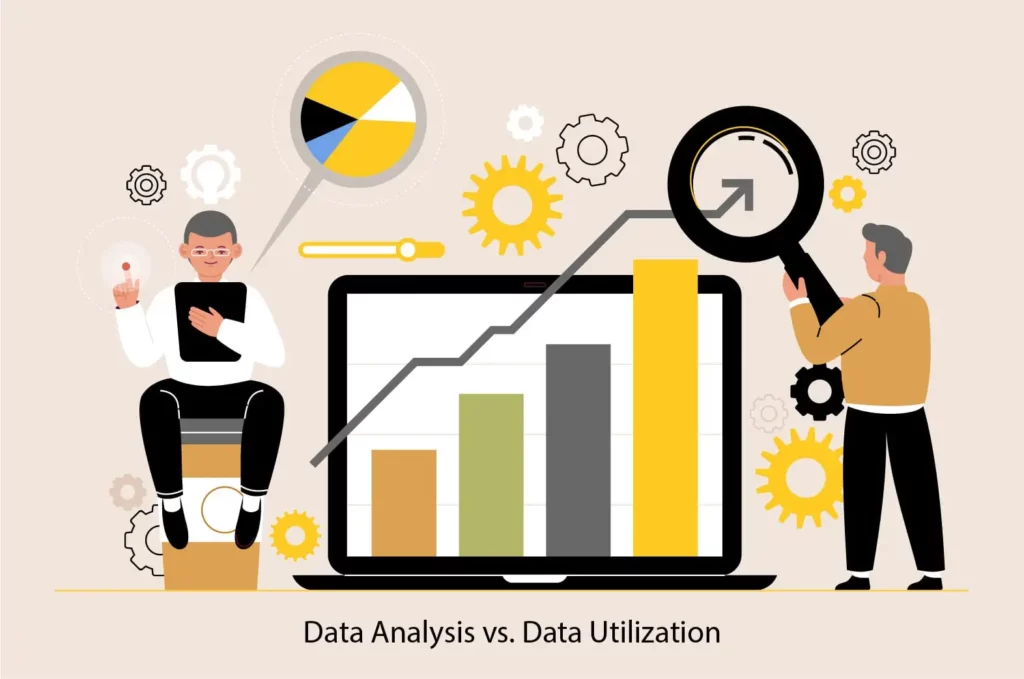
Data utilization is the process of continuously using data to achieve improved business outcomes like higher productivity and profitability. Governments, organizations, and businesses are generating vast amounts of data as digital transformation sweeps the globe. But what use would this data be if not utilized for the right purposes? Thus, companies are focusing on the concept of data utilization to enable evidence-based decision-making. The goal is to achieve better business outcomes through increased productivity, profitability, and competitiveness.
Have you ever wondered why data is important? Data could be useful in many ways. Not only does it build our knowledge, but it also informs research. It helps organizations and businesses to establish baselines, standards, benchmarks, priorities, and goals to keep things kicking and moving forward. Organizational data helps businesses keep track of and review different business processes and workflows of essential systems. Data science is very deep. It helps businesses with targeted advertising, AI, and much more. Through this science, we are able to identify methods, processes, ways, and algorithms to deduce meaning and extract insights from the data.
Data-driven decision-making is now a core concept and practice in the business world.
This article explains the basics of data utilization, its importance, and how it benefits companies.
What is Data Utilization?
Before we answer that, we must ask this question. What is utilization, and what is utilization in business? Utilization refers to using something or making effective use of anything. It may involve practical and profitable use of something. In terms of business, utilization refers to the use of resources to accomplish targets and revenues. So now, what is data utilization?
Data utilization is the process of continuously using data to achieve improved business outcomes like higher productivity and profitability. This is where the term “data-driven” comes from. It implies the use of data to make business decisions. As such, BI and data analytics services are key to enabling data-driven processes and decisions.
Research suggests that over 90 percent of large businesses employ data utilization to achieve their goals. As for small and medium enterprises, roughly half of them rely on data to achieve their strategic goals.
In a nutshell, the world we inhabit is becoming tech-enabled and data-driven. All the companies worldwide are doubling down on ways to utilize data for better results.
However, many people confuse data analysis and utilization, erroneously conflating both terms. Let’s explore what each of these terms implies.
Data Analysis vs. Data Utilization

-
Data Analysis
The aim of data analysis is to extract actionable information from the data present. Data, on its own, is just a collection of raw information—numbers, etc. You need to process this data and organize it so that it benefits the organization.
Once data has been processed and organized, for example, in the form of graphs or charts, you can use it to obtain relevant information. After data is organized, you can identify outliers, regularities and irregularities, anomalies, correlations, and causal relationships.
If you want to perform a deeper analysis of your data, you will require statistical knowledge and command of data processing techniques. Alternatively, you could use a business intelligence tool like Microsoft’s Power BI to perform advanced data analysis. Microsoft Power BI does not require its users to be experts in statistical or data processing techniques. Hence its ease of use makes it a convenient business intelligence tool.
Also, Power BI consulting services enable companies to be self-sufficient with minimum training and maintain the dashboards themselves.
Tableau is another very trendy data visualization tool, but it requires more technical knowledge on the part of its users for them to utilize Tableau professional services to its fullest extent.
-
Data Utilization
Data utilization is all about using the data for the benefit of your organization. This process necessitates first outlining the goal(s) you want to achieve using the given data. Once you have set the plans for it, it becomes easier for you to decide which strategies to implement and what actions to take.
You will base your strategy on the data analysis performed earlier. After executing the plan, you will have to verify its results and efficacy. This turns into an iterative process, where you implement a PDCA (Plan-Do-Check-Act) cycle to utilize the data and demonstrate its outcomes. Some key data utilization strategies include data mining, visualization, integration, quality management, and more.
However, it would help you in no small way to have prior marketing and data knowledge. Such knowledge enables you to choose the best possible data utilization strategy and verify its outcomes. Some key data utilization strategies include data mining, visualization, integration, quality management, and medical billing audit to ensure accuracy in healthcare billing data.
So, you can say that data analysis is about transforming raw information into organized data that can be utilized. Thus, data utilization entails using data from data analysis to make business decisions. Therefore, data analysis is a prerequisite for data utilization.
Moreover, each requires a separate skill set. Data analysis is technical in nature and entails using statistical and data processing methods. On the other hand, data utilization is more strategic in nature and requires you to have business and marketing knowledge.
In recent times, many companies have deployed BI tools like Power BI to perform data analysis and data integration, while data utilization remains the responsibility of humans.
Advantages of Data Utilization
We have seen data is extremely instrumental for us in different ways. Data is the main key that measures the effectiveness, efficiency, and practicality of a given strategy or approach. Not only does it support organizational decision-making but also new strategies. It gives important insight into how the company is performing. Utilizing data offers immense benefits to businesses. Here are some of the top advantages of using data for your business.
-
Understanding the Present Situation & Predicting Future Trends
The most essential and foremost benefit of using data is that you can clearly understand how your business is currently performing. Not only that, but it also helps you identify and predict how your business will perform in the future.
Therefore, based on the organized data in your possession, you can improve your business performance and chart effective strategies. Let’s substantiate this by citing an example.
If you have access to real-time information about your warehouse and the products in your inventory, you can use it to streamline your inventory management. Thus, it can help you cut down on storage costs by keeping your stock levels at the optimal level. Similarly, you won’t face any surplus or goods shortage if you correctly utilize your data.
-
Faster Decision-making
Hands-on access to actionable data reduces the time it takes to make critical business decisions. For example, the data will either favor your decision or go against it – there will hardly be room for subjectivity in your choices.
This ties in closely with the adage “show, don’t tell.” You have to show the data to substantiate your decisions instead of proffering long explanations based on personal or past experiences. Moreover, you can easily verify your results in the future by using data.
-
New Business Opportunities & Customer Insights
Data utilization can uncover new business opportunities and possibilities while also bringing to light previously unnoticed issues. Data visualization tools like Tableau can help find trends in buying patterns and preferences. These may lead you to identify new product development opportunities based on the data.
Similarly, businesses (both online and offline) can use data to understand how their target audiences move about the store, which products they seem interested in, and which ones they eventually buy.
All this helps you tailor your marketing strategy accordingly.
-
Improved Supply Chain Management
We live in a world where international trade is governed by intricate and complex global supply chains spanning multiple countries and continents. We took this globalization of capital and trade for granted until the COVID-19 pandemic hit us and disrupted supply chains, bringing major economies to a standstill.
However, with access to data and predictive analytics, you can spread your supply chain risk and avoid possible disruptions to your supply chain by making timely decisions and finding alternative sources of supply.
-
Innovation
With so much data present all around us, innovation is usually a matter of finding trends, doing research, and adding a bit of inspiration to the mix. In fact, data itself is a very precious product. Many companies (especially tech giants and social media conglomerates) gather data and sell it to third parties at exorbitant rates.
While this may seem unethical to many, the fact is that any service for which you do not pay means that you are the product itself. Nobody cares to read the “Terms & Conditions” of various online businesses. All this unique data that sheds light on people’s behavior patterns helps companies innovate and come up with new products.
Thus, data-driven innovation is an opportunity many companies are looking to benefit from.
Conclusion
In a tech-enabled world, data reigns supreme. However, raw data is of use once it is organized in such a manner that it can be utilized for business purposes. The two processes of data analysis and data utilization help you achieve this.
Once you have performed data analysis, you can utilize it to achieve your business objectives!
If you want to know more about data utilization, contact us at [email protected].
FAQs
Q: Why is data utilization important?
A: Data utilization is crucial as it enables informed decision-making, enhances efficiency, and drives innovation in businesses.
Q: What is data and why is it important?
A: Data refers to information in various forms, and its importance lies in its role as a valuable asset for insights, trends analysis, and strategic planning.
Q: How do you manage data utilization?
A3: Effective data utilization involves data collection, storage, analysis, and security measures to ensure accurate and secure information handling.
